This is the multi-page printable view of this section. Click here to print.
Introduction
1 - What is Talos?
Talos is a container optimized Linux distro; a reimagining of Linux for distributed systems such as Kubernetes. Designed to be as minimal as possible while still maintaining practicality. For these reasons, Talos has a number of features unique to it:
- it is immutable
- it is atomic
- it is ephemeral
- it is minimal
- it is secure by default
- it is managed via a single declarative configuration file and gRPC API
Talos can be deployed on container, cloud, virtualized, and bare metal platforms.
Why Talos
In having less, Talos offers more. Security. Efficiency. Resiliency. Consistency.
All of these areas are improved simply by having less.
2 - Quickstart
Local Docker Cluster
The easiest way to try Talos is by using the CLI (talosctl) to create a cluster on a machine with docker installed.
Prerequisites
talosctl
Download talosctl:
amd64
curl -Lo /usr/local/bin/talosctl https://github.com/siderolabs/talos/releases/download/v1.2.8/talosctl-$(uname -s | tr "[:upper:]" "[:lower:]")-amd64
chmod +x /usr/local/bin/talosctl
arm64
For linux and darwin operating systems talosctl is also available for the arm64 processor architecture.
curl -Lo /usr/local/bin/talosctl https://github.com/siderolabs/talos/releases/download/v1.2.8/talosctl-$(uname -s | tr "[:upper:]" "[:lower:]")-arm64
chmod +x /usr/local/bin/talosctl
kubectl
Download kubectl via one of methods outlined in the documentation.
Create the Cluster
Now run the following:
talosctl cluster create
Verify that you can reach Kubernetes:
$ kubectl get nodes -o wide
NAME STATUS ROLES AGE VERSION INTERNAL-IP EXTERNAL-IP OS-IMAGE KERNEL-VERSION CONTAINER-RUNTIME
talos-default-controlplane-1 Ready master 115s v1.25.5 10.5.0.2 <none> Talos (v1.2.8) <host kernel> containerd://1.5.5
talos-default-worker-1 Ready <none> 115s v1.25.5 10.5.0.3 <none> Talos (v1.2.8) <host kernel> containerd://1.5.5
Destroy the Cluster
When you are all done, remove the cluster:
talosctl cluster destroy
3 - Getting Started
This document will walk you through installing a full Talos Cluster. If this is your first use of Talos Linux, we recommend the Quickstart first, to quickly create a local virtual cluster on your workstation.
Regardless of where you run Talos, in general you need to:
- acquire the installation image
- decide on the endpoint for Kubernetes
- optionally create a load balancer
- configure Talos
- configure
talosctl - bootstrap Kubernetes
Prerequisites
talosctl
talosctl is a CLI tool which interfaces with the Talos API in
an easy manner.
Install talosctl before continuing:
amd64
curl -Lo /usr/local/bin/talosctl https://github.com/siderolabs/talos/releases/download/v1.2.8/talosctl-$(uname -s | tr "[:upper:]" "[:lower:]")-amd64
chmod +x /usr/local/bin/talosctl
arm64
For linux and darwin operating systems talosctl is also available for the arm64 architecture.
curl -Lo /usr/local/bin/talosctl https://github.com/siderolabs/talos/releases/download/v1.2.8/talosctl-$(uname -s | tr "[:upper:]" "[:lower:]")-arm64
chmod +x /usr/local/bin/talosctl
Acquire the installation image
The most general way to install Talos is to use the ISO image (note there are easier methods for some platforms, such as pre-built AMIs for AWS - check the specific Installation Guides.)
The latest ISO image can be found on the Github Releases page:
- X86: https://github.com/siderolabs/talos/releases/download/v1.2.8/talos-amd64.iso
- ARM64: https://github.com/siderolabs/talos/releases/download/v1.2.8/talos-arm64.iso
When booted from the ISO, Talos will run in RAM, and will not install itself until it is provided a configuration. Thus, it is safe to boot the ISO onto any machine.
Alternative Booting
For network booting and self-built media, you can use the published kernel and initramfs images:
Note that to use alternate booting, there are a number of required kernel parameters. Please see the kernel docs for more information.
Decide the Kubernetes Endpoint
In order to configure Kubernetes, Talos needs to know what the endpoint (DNS name or IP address) of the Kubernetes API Server will be.
The endpoint should be the fully-qualified HTTP(S) URL for the Kubernetes API Server, which (by default) runs on port 6443 using HTTPS.
Thus, the format of the endpoint may be something like:
https://192.168.0.10:6443https://kube.mycluster.mydomain.com:6443https://[2001:db8:1234::80]:6443
The Kubernetes API Server endpoint, in order to be highly available, should be configured in a way that functions off all available control plane nodes. There are three common ways to do this:
Dedicated Load-balancer
If you are using a cloud provider or have your own load-balancer (such as HAProxy, nginx reverse proxy, or an F5 load-balancer), using a dedicated load balancer is a natural choice. Create an appropriate frontend matching the endpoint, and point the backends at the addresses of each of the Talos control plane nodes. (Note that given we have not yet created the control plane nodes, the IP addresses of the backends may not be known yet. We can bind the backends to the frontend at a later point.)
Layer 2 Shared IP
Talos has integrated support for serving Kubernetes from a shared/virtual IP address. This method relies on Layer 2 connectivity between control plane Talos nodes.
In this case, we choose an unused IP address on the same subnet as the Talos control plane nodes. For instance, if your control plane node IPs are:
- 192.168.0.10
- 192.168.0.11
- 192.168.0.12
you could choose the ip 192.168.0.15 as your shared IP address.
(Make sure that 192.168.0.15 is not used by any other machine and that your DHCP server
will not serve it to any other machine.)
Once chosen, form the full HTTPS URL from this IP:
https://192.168.0.15:6443
If you create a DNS record for this IP, note you will need to use the IP address itself, not the DNS name, to configure the shared IP (machine.network.interfaces[].vip.ip) in the Talos configuration.
For more information about using a shared IP, see the related Guide
DNS records
If neither of the other methods work for you, you can use DNS records to provide a measure of redundancy. In this case, you would add multiple A or AAAA records (one for each control plane node) to a DNS name.
For instance, you could add:
kube.cluster1.mydomain.com IN A 192.168.0.10
kube.cluster1.mydomain.com IN A 192.168.0.11
kube.cluster1.mydomain.com IN A 192.168.0.12
Then, your endpoint would be:
https://kube.cluster1.mydomain.com:6443
Decide how to access the Talos API
Many administrative tasks are performed by calling the Talos API on Talos Linux control plane nodes.
We recommend accessing the control plane nodes directly from the talosctl client, if possible (i.e. set your endpoints to the IP addresses of the control plane nodes).
This requires your control plane nodes to be reachable from the client IP.
If the control plane nodes are not directly reachable from the workstation where you run talosctl, then configure a load balancer for TCP port 50000 to be forwarded to the control plane nodes.
Do not use Talos Linux’s built in VIP support for accessing the Talos API, as it will not function in the event of an etcd failure, and you will not be able to access the Talos API to fix things.
If you create a load balancer to forward the Talos API calls, make a note of the IP or
hostname so that you can configure your talosctl tool’s endpoints below.
Configure Talos
When Talos boots without a configuration, such as when using the Talos ISO, it enters a limited maintenance mode and waits for a configuration to be provided.
In other installation methods, a configuration can be passed in on boot.
For example, Talos can be booted with the talos.config kernel
commandline argument set to an HTTP(s) URL from which it should receive its
configuration.
Where a PXE server is available, this is much more efficient than
manually configuring each node.
If you do use this method, note that Talos requires a number of other
kernel commandline parameters.
See required kernel parameters.
If creating EC2 kubernetes clusters, the configuration file can be passed in as --user-data to the aws ec2 run-instances command.
In any case, we need to generate the configuration which is to be provided:
talosctl gen config cluster-name cluster-endpoint
Here, cluster-name is an arbitrary name for the cluster, used
in your local client configuration as a label.
It should be unique in the configuration on your local workstation.
The cluster-endpoint is the Kubernetes Endpoint you
selected from above.
This is the Kubernetes API URL, and it should be a complete URL, with https://
and port.
(The default port is 6443, but you may have configured your load balancer to forward a different port.)
For example:
talosctl gen config my-cluster https://192.168.64.15:6443
generating PKI and tokens
created /Users/taloswork/controlplane.yaml
created /Users/taloswork/worker.yaml
created /Users/taloswork/talosconfig
When you run this command, a number of files are created in your current directory:
controlplane.yamlworker.yamltalosconfig
The .yaml files are Machine Configs.
They provide Talos Linux servers their complete configuration,
describing everything from what disk Talos should be installed on, to network settings.
The controlplane.yaml file describes how Talos should form a Kubernetes cluster.
The talosconfig file (which is also YAML) is your local client configuration file.
Controlplane and Worker
The two types of Machine Configs correspond to the two roles of Talos nodes, control plane (which run both the Talos and Kubernetes control planes) and worker nodes (which run the workloads).
The main difference between Controlplane Machine Config files and Worker Machine Config files is that the former contains information about how to form the Kubernetes cluster.
Modifying the Machine configs
The generated Machine Configs have defaults that work for many cases.
They use DHCP for interface configuration, and install to /dev/sda.
If the defaults work for your installation, you may use them as is.
Sometimes, you will need to modify the generated files so they work with your systems. A common example is needing to change the default installation disk. If you try to to apply the machine config to a node, and get an error like the below, you need to specify a different installation disk:
talosctl apply-config --insecure -n 192.168.64.8 --file controlplane.yaml
error applying new configuration: rpc error: code = InvalidArgument desc = configuration validation failed: 1 error occurred:
* specified install disk does not exist: "/dev/sda"
You can verify which disks your nodes have by using the talosctl disks --insecure command.
Insecure mode is needed at this point as the PKI infrastructure has not yet been set up.
For example:
talosctl -n 192.168.64.8 disks --insecure
DEV MODEL SERIAL TYPE UUID WWID MODALIAS NAME SIZE BUS_PATH
/dev/vda - - HDD - - virtio:d00000002v00001AF4 - 69 GB /pci0000:00/0000:00:06.0/virtio2/
In this case, you would modiy the controlplane.yaml and worker.yaml and edit the line:
install:
disk: /dev/sda # The disk used for installations.
to reflect vda instead of sda.
Machine Configs as Templates
Individual machines may need different settings: for instance, each may have a different static IP address.
When different files are needed for machines of the same type, simply
copy the source template (controlplane.yaml or worker.yaml) and make whatever
modifications are needed.
For instance, if you had three control plane nodes and three worker nodes, you may do something like this:
for i in $(seq 0 2); do
cp controlplane.yaml cp$i.yaml
end
for i in $(seq 0 2); do
cp worker.yaml w$i.yaml
end
Then modify each file as needed.
Apply Configuration
To apply the Machine Configs, you need to know the machines’ IP addresses.
Talos will print out the IP addresses of the machines on the console during the boot process:
[4.605369] [talos] task loadConfig (1/1): this machine is reachable at:
[4.607358] [talos] task loadConfig (1/1): 192.168.0.2
[4.608766] [talos] task loadConfig (1/1): server certificate fingerprint:
[4.611106] [talos] task loadConfig (1/1): xA9a1t2dMxB0NJ0qH1pDzilWbA3+DK/DjVbFaJBYheE=
[4.613822] [talos] task loadConfig (1/1):
[4.614985] [talos] task loadConfig (1/1): upload configuration using talosctl:
[4.616978] [talos] task loadConfig (1/1): talosctl apply-config --insecure --nodes 192.168.0.2 --file <config.yaml>
[4.620168] [talos] task loadConfig (1/1): or apply configuration using talosctl interactive installer:
[4.623046] [talos] task loadConfig (1/1): talosctl apply-config --insecure --nodes 192.168.0.2 --mode=interactive
[4.626365] [talos] task loadConfig (1/1): optionally with node fingerprint check:
[4.628692] [talos] task loadConfig (1/1): talosctl apply-config --insecure --nodes 192.168.0.2 --cert-fingerprint 'xA9a1t2dMxB0NJ0qH1pDzilWbA3+DK/DjVbFaJBYheE=' --file <config.yaml>
If you do not have console access, the IP address may also be discoverable from your DHCP server.
Once you have the IP address, you can then apply the correct configuration.
talosctl apply-config --insecure \
--nodes 192.168.0.2 \
--file controlplane.yaml
The insecure flag is necessary because the PKI infrastructure has not yet been made available to the node. Note: the connection will be encrypted, it is just unauthenticated. If you have console access you can extract the server certificate fingerprint and use it for an additional layer of validation:
talosctl apply-config --insecure \
--nodes 192.168.0.2 \
--cert-fingerprint xA9a1t2dMxB0NJ0qH1pDzilWbA3+DK/DjVbFaJBYheE= \
--file cp0.yaml
Using the fingerprint allows you to be sure you are sending the configuration to the correct machine, but it is completely optional. After the configuration is applied to a node, it will reboot. Repeat this process for each of the nodes in your cluster.
Understand talosctl, endpoints and nodes
It is important to understand the concept of endpoints and nodes.
In short: endpoints are the nodes that talosctl sends commands to, but nodes are the nodes that the command operates on.
The endpoint will forward the command to the nodes, if needed.
Endpoints
Endpoints are the IP addresses to which the talosctl client directly talks.
These should be the set of control plane nodes, either directly or through a load balancer.
Each endpoint will automatically proxy requests destined to another node in the cluster. This means that you only need access to the control plane nodes in order to access the rest of the network.
talosctl will automatically load balance requests and fail over between all of your endpoints.
You can pass in --endpoints <IP Address1>,<IP Address2> as a comma separated list of IP/DNS addresses to the current talosctl command.
You can also set the endpoints in your talosconfig, by calling talosctl config endpoint <IP Address1> <IP Address2>.
Note: these are space separated, not comma separated.
As an example, if the IP addresses of our control plane nodes are:
- 192.168.0.2
- 192.168.0.3
- 192.168.0.4
We would set those in the talosconfig with:
talosctl --talosconfig=./talosconfig \
config endpoint 192.168.0.2 192.168.0.3 192.168.0.4
Nodes
The node is the target you wish to perform the API call on.
When specifying nodes, their IPs and/or hostnames are as seen by the endpoint servers, not as from the client. This is because all connections are proxied through the endpoints.
You may provide -n or --nodes to any talosctl command to supply the node or (comma-separated) nodes on which you wish to perform the operation.
For example, to see the containers running on node 192.168.0.200:
talosctl -n 192.168.0.200 containers
To see the etcd logs on both nodes 192.168.0.10 and 192.168.0.11:
talosctl -n 192.168.0.10,192.168.0.11 logs etcd
It is possible to set a default set of nodes in the talosconfig file, but our recommendation is to explicitly pass in the node or nodes to be operated on with each talosctl command.
For a more in-depth discussion of Endpoints and Nodes, please see talosctl.
Default configuration file
You can reference which configuration file to use directly with the --talosconfig parameter:
talosctl --talosconfig=./talosconfig \
--nodes 192.168.0.2 version
However, talosctl comes with tooling to help you integrate and merge this configuration into the default talosctl configuration file.
This is done with the merge option.
talosctl config merge ./talosconfig
This will merge your new talosconfig into the default configuration file ($XDG_CONFIG_HOME/talos/config.yaml), creating it if necessary.
Like Kubernetes, the talosconfig configuration files has multiple “contexts” which correspond to multiple clusters.
The <cluster-name> you chose above will be used as the context name.
Kubernetes Bootstrap
Bootstrapping your Kubernetes cluster with Talos is as simple as:
talosctl bootstrap --nodes 192.168.0.2
The bootstrap operation should only be called ONCE and only on a SINGLE control plane node!
The IP can be any of your control planes (or the loadbalancer, if used for the Talos API endpoint).
At this point, Talos will form an etcd cluster, generate all of the core Kubernetes assets, and start the Kubernetes control plane components.
After a few moments, you will be able to download your Kubernetes client configuration and get started:
talosctl kubeconfig
Running this command will add (merge) you new cluster into your local Kubernetes configuration.
If you would prefer the configuration to not be merged into your default Kubernetes configuration file, pass in a filename:
talosctl kubeconfig alternative-kubeconfig
You should now be able to connect to Kubernetes and see your nodes:
kubectl get nodes
And use talosctl to explore your cluster:
talosctl -n <NODEIP> dashboard
For a list of all the commands and operations that talosctl provides, see the CLI reference.
4 - Theila UI for Talos
Once you have a Talos cluster running, you may find it easier to get insights on your cluster(s) using a visual user interface rather than the talosctl CLI.
For this, Sidero Labs provides Theila, a simple, single-binary web-based visual user interface for Talos clusters.
Prerequisites
You should have a Talos cluster up & running, and the talosconfig file for Theila to access it.
Installation
Theila is published as a single static binary compiled for various platforms and architectures, as well as a container image.
Binary
You can download the correct binary for your system from the releases page, or use the following commands in your terminal.
curl -Lo /usr/local/bin/theila https://github.com/siderolabs/theila/releases/download/v0.2.1/theila-$(uname -s | tr "[:upper:]" "[:lower:]")-amd64
chmod +x /usr/local/bin/theila
Use
Once installed, you can run Theila by simply running it.
# address and port are not required and default to the values shown
theila --address 127.0.0.1 --port 8080docker run --rm --volume ${HOME}/.talos/config:/opt/talosconfig:ro --env TALOSCONFIG=/opt/talosconfig --publish 8080:8080 ghcr.io/siderolabs/theila --address 0.0.0.0Once it is running you should be able to point a browser at http://localhost:8080 to open the Theila UI.
Clusters
You can navigate around various Talos clusters using the menu at the upper-left corner (see 1.1), then selecting the specific cluster from the list (see 1.2).
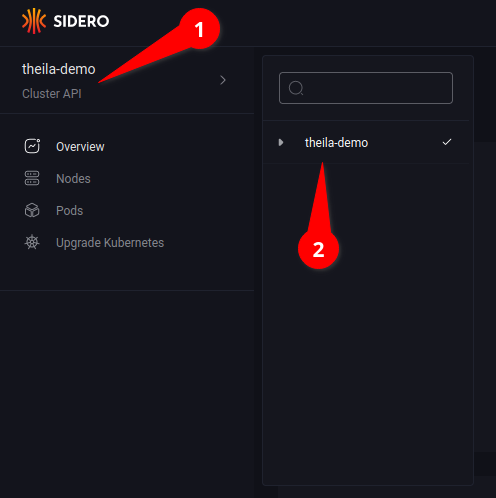
Cluster Overview
Clicking on the “Overview” option in the menu (see 2.1) will display an overview of resource use & health of the cluster.
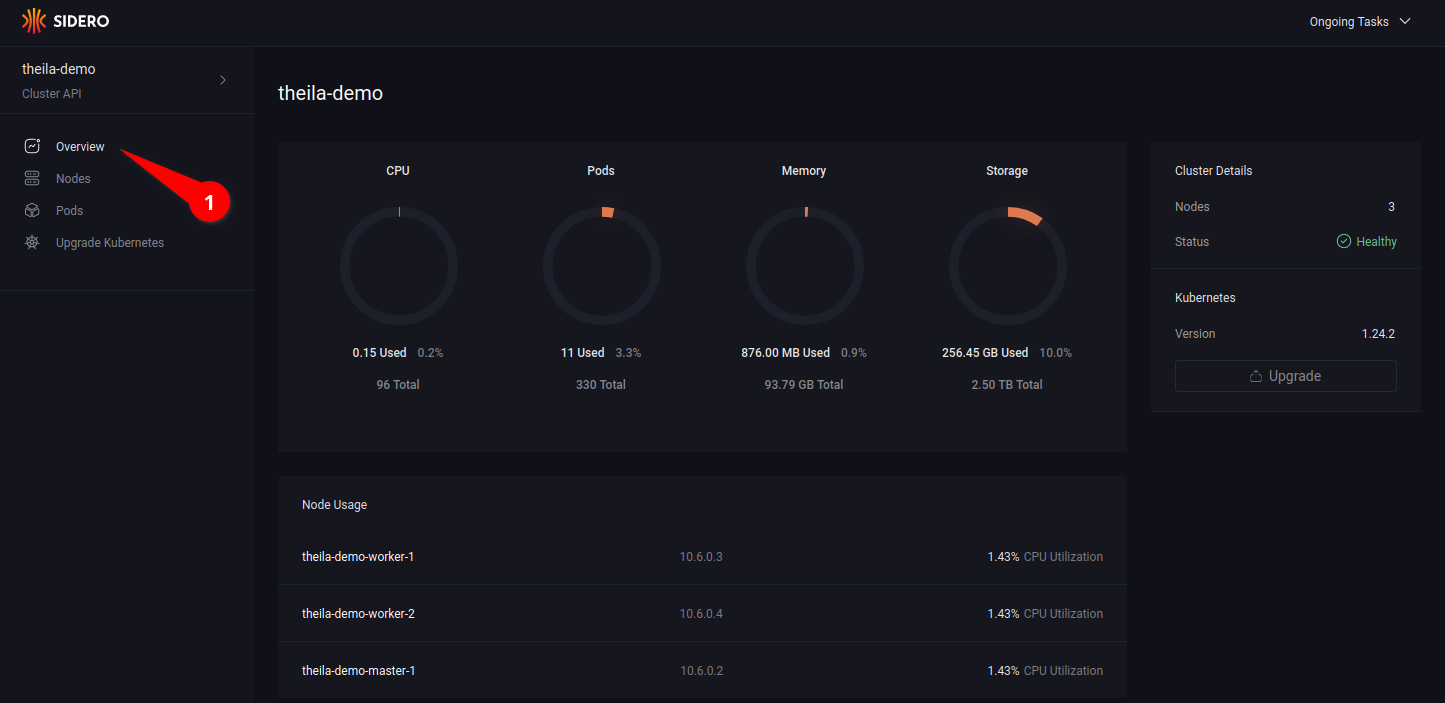
Nodes
Entering the “Nodes” section on the menu (see 3.1) will give a list of nodes in the cluster (see 3.2), along with information such as IP address, status, and any roles assigned to the node.
Opening the node menu (see 3.3) show the actions that can be taken on a specific node.

Clicking on a specific node name in the node list will open the node detail page for more information on each specific node (see 4.1), including running services and their logs (see 4.2).
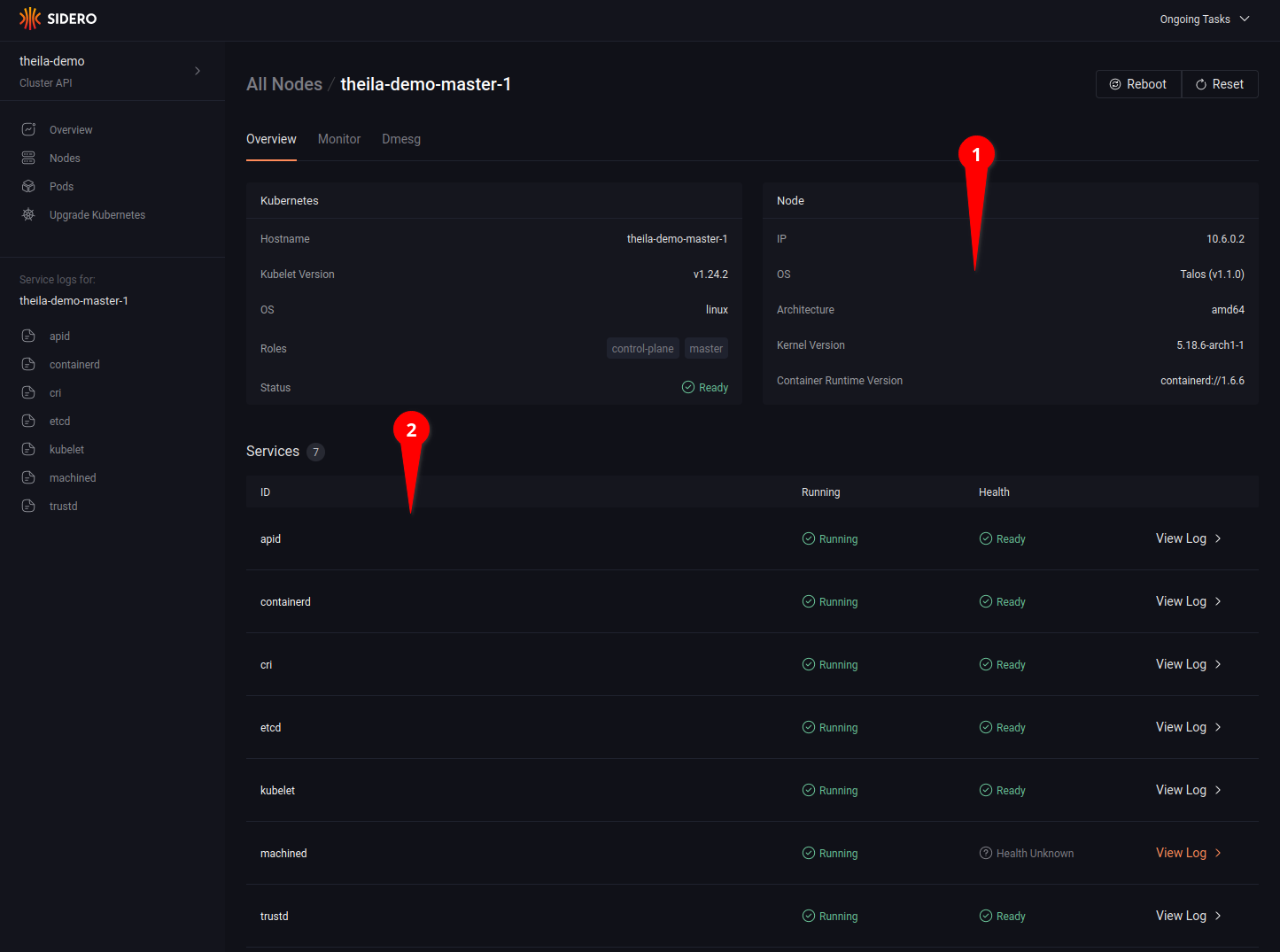
Clicking on the “Monitor” tab (see 5.1) allows you to watch resource use over time, with CPU and memory consumption graphs updated in real time, and a detailed list of running process each with their individual resource use (see 5.2).
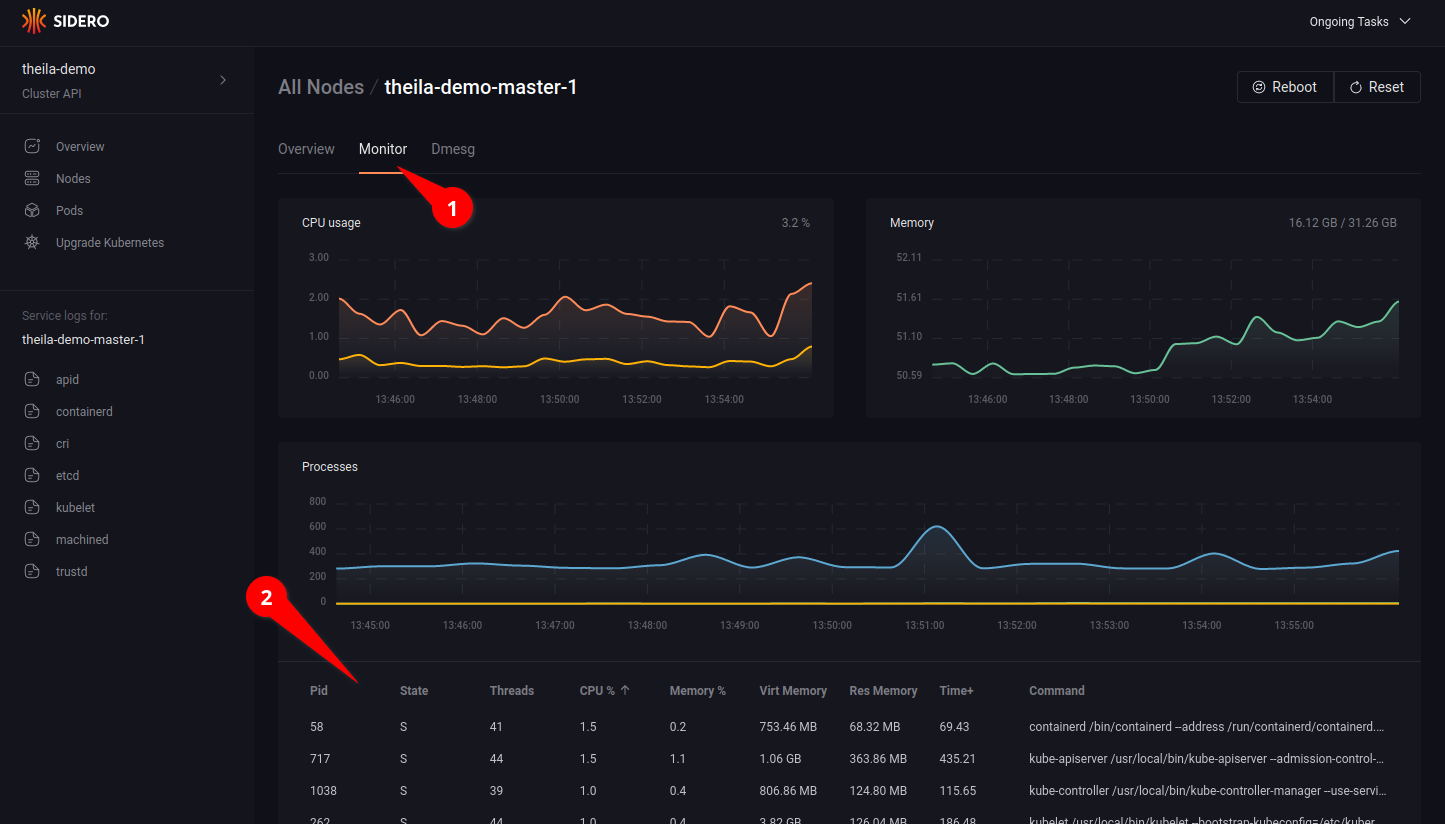
Lastly, the “Dmesg” tab shows all kernel messages of the node since boot.
Pods
Using the “Pods” section on the menu (see 6.1) will list all pods in the cluster, across all namespaces.
Clicking on the drop-down arrow (see 6.2) will open up more detailed information of the specified pod.
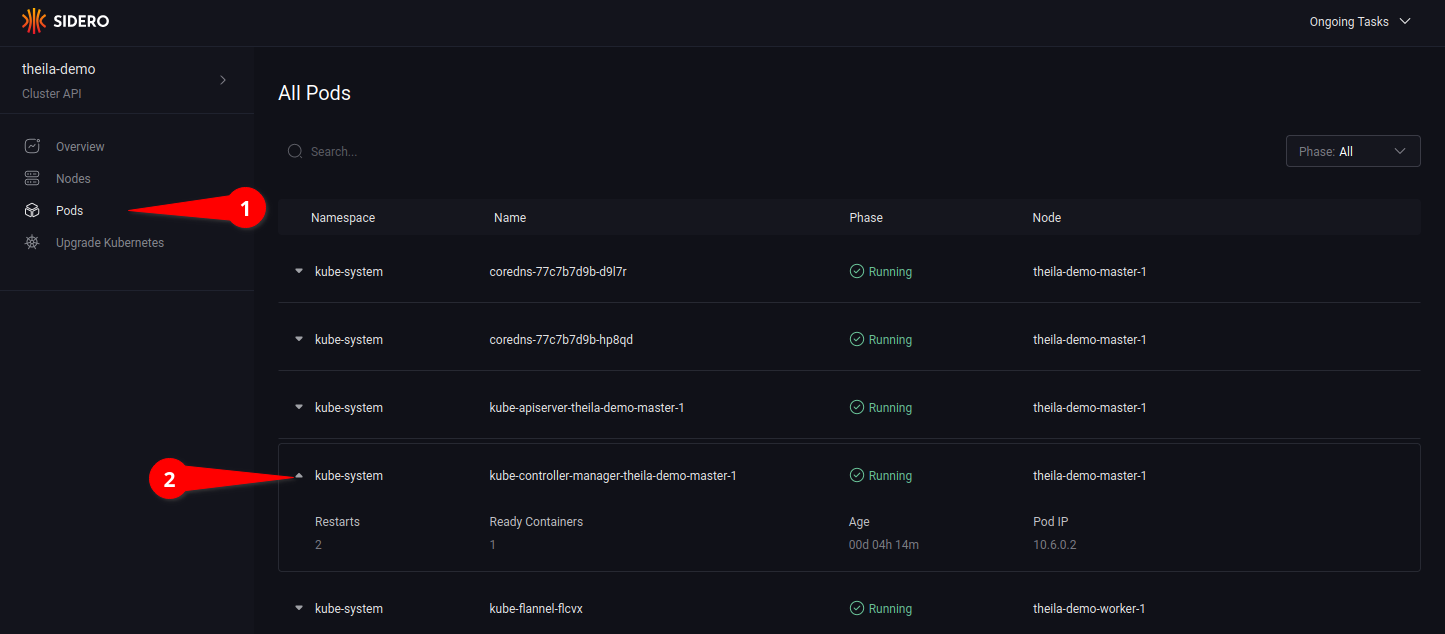
5 - System Requirements
Minimum Requirements
| Role | Memory | Cores |
|---|---|---|
| Control Plane | 2GB | 2 |
| Worker | 1GB | 1 |
Recommended
| Role | Memory | Cores |
|---|---|---|
| Control Plane | 4GB | 4 |
| Worker | 2GB | 2 |
These requirements are similar to that of kubernetes.
6 - What's New in Talos 1.2
See also upgrade notes for important changes.
Component Updates
- Linux: 5.15.64
- Flannel 0.19.1
- containerd 1.6.8
- runc: v1.1.4
- Kubernetes: v1.25.0
Talos is built with Go 1.19.
Kubernetes
Control Plane Labels and Taints
Talos now defaults to node-role.kubernetes.io/control-plane label/taint.
On upgrades Talos now removes the node-role.kubernetes.io/master label/taint on control-plane nodes and replaces it with the node-role.kubernetes.io/control-plane label/taint.
Workloads that tolerate the old taints or have node selectors with the old labels will need to be updated.
Previously Talos labeled control plane nodes with both
control-planeandmasterlabels and tainted the node withmastertaint.
Scheduling on Control Plane Nodes
Machine configuration .cluster.allowSchedulingOnMasters is deprecated and replaced by .cluster.allowSchedulingOnControlPlanes.
The .cluster.allowSchedulingOnMasters will be removed in a future release of Talos.
If both .cluster.allowSchedulingOnMasters and .cluster.allowSchedulingOnControlPlanes are set to true, the .cluster.allowSchedulingOnControlPlanes will be used.
Control Plane Components
Talos now run all Kubernetes Control Plane Components with the CRI default Seccomp Profile and other recommendations as described in KEP-2568.
k8s.gcr.io Registry
Talos now defaults to adding a registry mirror configuration in the machine configuration for k8s.gcr.io pointing to both registry.k8s.io and k8s.gcr.io unless overridden.
This is in line with the Kubernetes 1.25 release having the new registry.k8s.io registry endpoint.
This is only enabled by default on newly generated configurations and not on upgrades. This can be enabled with a machine configuration as follows:
machine:
registries:
mirrors:
k8s.gcr.io:
endpoints:
- https://registry.k8s.io
- https://k8s.gcr.io
seccomp Profiles
Talos now supports creating custom seccomp profiles on the host machine which in turn can be used by Kubernetes workloads. It can be configured in the machine config as below:
machine:
seccompProfiles:
- name: audit.json
value:
defaultAction: SCMP_ACT_LOG
- name: deny.json
value: {"defaultAction":"SCMP_ACT_LOG"}
This profile data can be either configured as a YAML definition or as a JSON string.
The profiles are created on the host under /var/lib/kubelet/seccomp/profiles.
Default seccomp Profile
Talos now runs Kubelet with the CRI default Seccomp Profile enabled.
This can be disabled by setting .machine.kubelet.defaultRuntimeSeccompProfileEnabled to false.
This feature is not enabled automatically on upgrades, so upgrading to Talos v1.2 needs this to be explicitly enabled.
See documentation for more details.
Machine Configuration
Strategic Merge Patching
In addition to JSON (RFC6902) patches Talos now supports strategic merge patching.
For example, machine hostname can be set with the following patch:
machine:
network:
hostname: worker1
Patch format is detected automatically.
talosctl apply-config
talosctl apply-config now supports patching the machine config file in memory before submitting it to the node.
Networking
Bridge Support
Talos now supports configuration of Linux bridge interfaces:
machine:
network:
interfaces:
- interface: br0
bridge:
stp:
enabled: true
interfaces:
- eth0
- eth1
See configuration reference for more details.
VLANs
Talos now supports dracut-style vlan kernel argument to allow
installing Talos Linux in networks where ports are not tagged
with a default VLAN:
vlan=eth1.5:eth1 ip=172.20.0.2::172.20.0.1:255.255.255.0::eth1.5:::::
Machine configuration now supports specifying DHCP options for VLANs.
Stable Default Hostname
Talos now generates the default hostname (when there is no explicitly specified hostname) for the nodes based on the
node id (e.g. talos-2gd-76y) instead of using the DHCP assigned IP address (e.g. talos-172-20-0-2).
This ensures that the node hostname is not changed when DHCP assigns a new IP to a node.
Note: the stable hostname generation algorithm changed between v1.2.0-beta.0 and v1.2.0-beta.1, please take care when upgrading from versions >= 1.2.0-alpha.1 to versions >= 1.2.0-beta.1 when using stable default hostname feature.
Packet Capture
Talos now supports capturing packets on a network interface with talosctl pcap command:
talosctl pcap --interface eth0
Cluster Discovery and KubeSpan
KubeSpan Kubernetes Network Advertisement
KubeSpan no longer by default advertises Kubernetes pod networks of the node over KubeSpan. This means that CNI should handle encapsulation of pod-to-pod traffic into the node-to-node tunnel, and node-to-node traffic will be handled by KubeSpan. This provides better compatibility with popular CNIs like Calico and Cilium.
Old behavior can be restored by setting .machine.kubespan.advertiseKubernetesNetworks = true in the machine config.
Kubernetes Discovery Backend
Kubernetes cluster discovery backend is now disabled by default for new clusters. This backend doesn’t provide any benefits over the Discovery Service based backend, while it causes issues for KubeSpan enabled clusters when control plane endpoint is KubeSpan-routed.
For air-gapped installations when the Discovery Service is not enabled, Kubernetes Discovery Backend can be enabled by applying the following machine configuration patch:
cluster:
discovery:
registries:
kubernetes:
disabled: false
etcd
Advertised and Listen Subnets
Machine configuration setting cluster.etcd.subnet is deprecated, but still supported.
Two new configuration settings are introduced to control precisely which subnet is used for etcd peer communication:
cluster:
etcd:
advertisedSubnets:
- 10.0.0.0/24
listenSubnets:
- 10.0.0.0/24
- 192.168.0.0/24
The advertisedSubnets setting is used to control which subnet is used for etcd peer communication, it will be advertised
by each peer for other peers to connect to.
If advertiseSubnets is set, listenSubnets defaults to the same value, so that
etcd only listens on the same subnet as it advertises.
Additional subnets can be configured in listenSubnets if needed.
Default behavior hasn’t changed - if the advertisedSubnets is not set, Talos picks up the first available network address as
an advertised address and etcd is configured to listen on all interfaces.
Note: most of the
etcdconfiguration changes are accepted on the fly, but they are fully applied only after a reboot.
CLI
Tracking Progress of API Calls
talosctl subcommands shutdown, reboot, reset and upgrade now have a new flag --wait to
wait until the operation is completed, displaying information on the current status of each node.
A new --debug flag is added to these commands to get the kernel logs output from these nodes if the operation fails.

Generating Machine Config from Secrets
It is now possible to pre-generate secret material for the cluster with talosctl gen secrets:
talosctl gen secrets -o cluster1-secrets.yaml
Secrets file should be stored in a safe place, and machine configuration for the node in the cluster can be generated on demand
with talosctl gen config:
talosctl gen config --with-secrets cluster1-secrets.yaml cluster1 https://cluster1.example.com:6443/
This way configuration can be generated on demand, for example with configuration patches. Nodes with machine configuration generated from the same secrets file can join each other to form a cluster.
Integrations
Talos API access from Kubernetes
Talos now supports access to its API from within Kubernetes.
It can be configured in the machine config as below:
machine:
features:
kubernetesTalosAPIAccess:
enabled: true
allowedRoles:
- os:reader
allowedKubernetesNamespaces:
- kube-system
This feature introduces a new custom resource definition, serviceaccounts.talos.dev.
Creating custom resources of this type will provide credentials to access Talos API from within Kubernetes.
The new CLI subcommand talosctl inject serviceaccount can be used to configure Kubernetes manifests with Talos service accounts as below:
talosctl inject serviceaccount -f manifests.yaml > manifests-injected.yaml
kubectl apply -f manifests-injected.yaml
See documentation for more details.
Migration
Migrating from kubeadm
talosctl gen command supports generating a secrets bundle from a Kubernetes PKI directory (e.g. /etc/kubernetes/pki).
This secrets bundle can then be used to generate a machine config.
This facilitates migrating clusters (e.g. created using kubeadm) to Talos.
talosctl gen secrets --kubernetes-bootstrap-token znzio1.1ifu15frz7jd59pv --from-kubernetes-pki /etc/kubernetes/pki
talosctl gen config --with-secrets secrets.yaml my-cluster https://172.20.0.1:6443
Platform Updates
Metal
The kernel parameter talos.config can now substitute system information into placeholders inside its URL query values.
This example shows all supported variables:
http://example.com/metadata?h=${hostname}&m=${mac}&s=${serial}&u=${uuid}
Extensions
NVIDIA GPU support promoted to beta
NVIDIA GPU support on Talos has been promoted to beta and SideroLabs now publishes the NVIDIA Open GPU Kernel Modules as a system extension making it easier to run GPU workloads on Talos. Refer to enabling NVIDIA GPU support docs here:
Deprecations
--masters flag on talosctl cluster create is deprecated.
Use --controlplanes instead.
Machine configuration .cluster.allowSchedulingOnMasters is deprecated and replaced by .cluster.allowSchedulingOnControlPlanes.
7 - Support Matrix
| Talos Version | 1.2 | 1.1 |
|---|---|---|
| Release Date | 2022-09-01 | 2022-06-22 (1.1.0) |
| End of Community Support | 1.3.0 release (2022-12-15) | 1.2.0 release (2022-09-01) |
| Enterprise Support | offered by Sidero Labs Inc. | offered by Sidero Labs Inc. |
| Kubernetes | 1.25, 1.24, 1.23 | 1.24, 1.23, 1.22 |
| Architecture | amd64, arm64 | amd64, arm64 |
| Platforms | ||
| - cloud | AWS, GCP, Azure, Digital Ocean, Hetzner, OpenStack, Oracle Cloud, Scaleway, Vultr, Upcloud | AWS, GCP, Azure, Digital Ocean, Hetzner, OpenStack, Oracle Cloud, Scaleway, Vultr, Upcloud |
| - bare metal | x86: BIOS, UEFI; arm64: UEFI; boot: ISO, PXE, disk image | x86: BIOS, UEFI; arm64: UEFI; boot: ISO, PXE, disk image |
| - virtualized | VMware, Hyper-V, KVM, Proxmox, Xen | VMware, Hyper-V, KVM, Proxmox, Xen |
| - SBCs | Banana Pi M64, Jetson Nano, Libre Computer Board ALL-H3-CC, Pine64, Pine64 Rock64, Radxa ROCK Pi 4c, Raspberry Pi 4B | Banana Pi M64, Jetson Nano, Libre Computer Board ALL-H3-CC, Pine64, Pine64 Rock64, Radxa ROCK Pi 4c, Raspberry Pi 4B |
| - local | Docker, QEMU | Docker, QEMU |
| Cluster API | ||
| CAPI Bootstrap Provider Talos | >= 0.5.5 | >= 0.5.3 |
| CAPI Control Plane Provider Talos | >= 0.4.9 | >= 0.4.6 |
| Sidero | >= 0.5.5 | >= 0.5.4 |
| UI | ||
| Theila | ✓ | ✓ |
Platform Tiers
- Tier 1: Automated tests, high-priority fixes.
- Tier 2: Tested from time to time, medium-priority bugfixes.
- Tier 3: Not tested by core Talos team, community tested.
Tier 1
- Metal
- AWS
- GCP
Tier 2
- Azure
- Digital Ocean
- OpenStack
- VMWare
Tier 3
- Hetzner
- nocloud
- Oracle Cloud
- Scaleway
- Vultr
- Upcloud